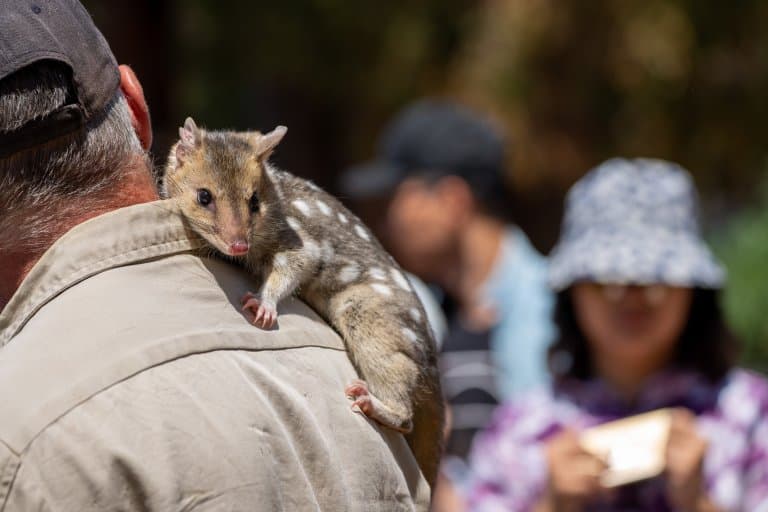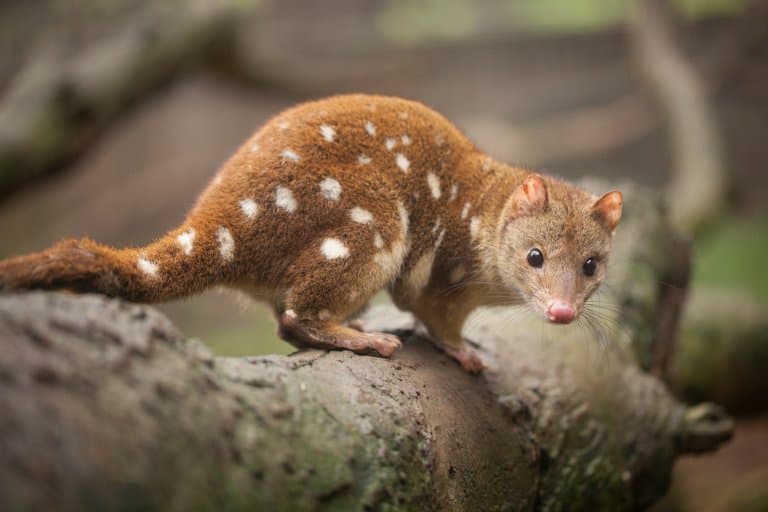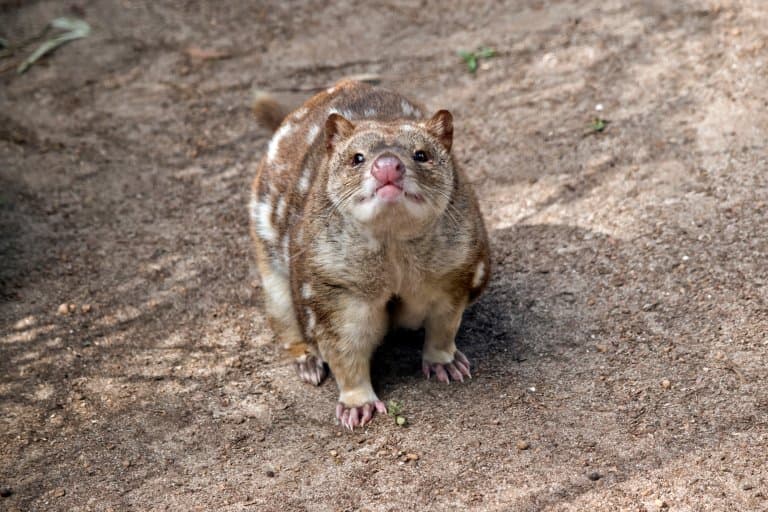Quoll Profile
The quoll is a small carnivorous marsupial found in Australia, Tasmania and New Guinea.
There are six species in total; four of these reside in Australia and Tasmania (the eastern quoll, the northern quoll, the western quoll, and the tiger quoll) and two in New Guinea (the bronze quoll and the New Guinean quoll).
All six species have distinct ranges within their location and inhabit a varierty of regions. The Western quoll lives in the more inland arid regions of South-West Australia, whereas the Northern quoll lives in the tropical/higher rainfall areas of Northern Australia.

Quoll Facts Overview
| Habitat: | Grassland, woodland, forests |
| Location: | Australia , Tasmania and New Guinea |
| Lifespan: | 3-6 years |
| Size: | 25 – 91 cm long, plus extensive tail |
| Weight: | 300g – 7kg |
| Color: | Long tail, pointed snout with a pink nose, ginger/brown/black thick fur with white spots covering the dorsal part of their bodies |
| Diet: | Fruits, nuts, insects, small lizards, amphibians, rabbits and other mammals |
| Predators: | Snakes, crocodiles, dingos, birds of prey |
| Top Speed: | 24 kph (15 mph) |
| No. of Species: |
6 |
| Conservation Status: |
New Guinean and Bronze quoll are near theatened, the Tiger and Western quoll are vulnerable, and the Eastern and Northern quoll are endangered |
Quolls differ in size, the smallest is thought to be the Northern quoll, measuring around 25 cms in length and only weighing between 300-1,100g. The largest is the tiger or spotted-tailed quoll, which can grow up to 3 feet in length, and weigh up to 7kg.
The fur color of quolls varies from a dark brown/black to ginger, however all have distinctive white spots that cover their bodies, and move to their tail in the case of the tiger quoll. They have a cat or weasel like stance, triangular faces and extremely sharp teeth and strong jaws, which serve them well as they are carnivorous in nature.
They feed on insects, birds, frogs, lizards to name just a few of their prey. The larger species will feed on certain species of mammal such as bandicoots and possums. Quolls will scavenge and feed on carrion, but can also consume fruits and nuts if necessary.
Quoll are nocturnal, spending the days in their dens and coming out at night to forage for food. They aren’t too fussy when it comes to where they live and can make their homes in anything from an underground burrow, to a termite mound and even a rocky fissure. They do not make their own dens and will change them regularly. Their habitats range from grassland to rocky outcrops and even coastal areas.
Quolls are mainly solitary marsupials, but will come together during the mating season to breed, with their home ranges being fairly large and the males’ overlapping. Males will defend their territories aggressively against any close trespassers.
The breeding season for quolls tends to occur in the autumn to winter seasons, with the males and females mating with multiple partners in this time. Males have been observed fighting with each other to gain access to the opposite sex.
Females give birth to many young, however usually only 6-8 pups survive. They are born after around 3 weeks and are under-developed. They stay in their mothers pouch or pouch like area and feed on milk. As they get older and bigger they move to her belly, and then her back, clinging to her fur and also moving into the den. They tend to reach full independence at around 5 months of age.
Sadly all species of quoll have experienced a significant decline in population since Australasia was colonised, with two species near threatened, two species vulnerable and two listed as endangered according to the ICUN Redlist.
Interesting Quoll Facts
1. Cane toads are a serious threat to quolls
The cane toad was introduced to Australia in the 1930s to help control pests, however it can poison the animals that try to eat it, including species of quoll. This has had a very negative impact on quoll numbers in Australia.
Interestingly some individuals who stay clear of cane toads have developed a system to pass on their non-toad eating ways to the next generations.

2. Their young are born the size of a grain of rice
When the offspring of the tiger quoll are born they are approximately the size of a grain of rice. The males of this species can reach up to 4kg in adulthood. 1
3. The quoll has an unlikely relative
One of the closest living relatives to the quoll is the Tasmanian devil. They are also related to the dunnart and a few other marsupials.
4. They are climbers
Although generally ground dwelling, quolls are actually very adept climbers. Smaller species of quoll are agile in the trees, scaling them looking for prey to consume.
The largest quoll, the tiger quoll can also climb trees to hunt for prey.
5. Many offspring don’t survive
When litters are born there can be anywhere between 8-30 individuals.
However sadly many of these die and the female is usually left with only 6-8 offspring, linked to the number of nipples she has to feed them milk with.
6. Early settlers called them ‘native cats’
They used to be called ‘native cats’ because of people observing their faces and canines and comparing them to a cats.
However this was later changed in the 1960s to the name quoll. Their genus Dasyurus means ‘hairy tail’.
Quolls are still referred to as “marsupial foxes” or “marsupial cats” today.2

7. Only the tiger quoll has a true pouch
The tiger quoll has a true pouch that opens towards the end of the body.
The other five species have folds that develop and stretch into a pouch like area when the females are pregnant.
8. The tiger quoll is the 2nd largest carnivorous marsupial in Australia
And the largest in mainland Australia, growing up to 3 feet in length – the size of a small dog. Their size enables them to occassionally hunt wallabies, and wombats on the ground.

9. Quolls communicate in a special way
Quolls have a good sense of smell and use communal latrines to communicate to each other regarding where their individual territories are.
They will also hiss, chirp and scream at each other if necessary, changing their vocalisation pitch depending on who they are communicating with (other species, pups, adults).
10. Not all pups will have the same father
In the same one litter that a female quoll has, the father of each offspring may differ.
Also in the first few litters that the females have, she will give birth to males generally. As she gets older this will change and become more female dominant litters.
11. Males live shorter lives than females
After males have mated for the first time in their lives they will usually die shortly after. Females will live longer, completing 2-3 seasons of mating.
12. They can travel up to 6km in a night
Quoll can have a large homeranges and have been known to travel long distances overnight when scavenging for food at night.

13. Foxes and feral cats are partly responsible for their decline
The introduction of foxes had a huge negative impact on quoll populations, as they not only compete for food such as rabbits, but also became prey for them. Feral cats will also prey on quolls.
The natural poison fluoroacetate (Compound 1080) is used in Australia to control pests, such as foxes, feral cats and dingos. Foxes have also been eradicated from many of the islands off the coast of Australia to aid their conservation.
While native animals were thought to be largely immune from the mass poisoning as it occurs naturally in plants, it’s believed to have had an impact on quoll numbers in certain areas – as juvenile quolls may be susceptible. 3
14. The Eastern quoll is now back in Australia
The Eastern quoll was wiped out from Australia for over 50 years linked to disease and foxes, however in 2018 they were re-introduced from Tasmania and are now successfully reproducing. 4

15. Conservation efforts continue
Quoll populations have dramatically declined due to habitat destruction through urbanisation and the introduction of invasive species.
However there are conservation efforts ongoing, including captive-breeding programs, reintroduction to different protected regions, and even research into creating a native pet industry for them to aid conservation.
Quoll Fact-File Summary
Scientific Classification
| Kingdom: | Animalia |
| Phylum: | Chordata |
| Class: | Mammalia |
| Order: | Dasyuromorphia |
| Family: | Dasyuridae |
| Genus: | Dasyurus |
| Species Names: |
Dasyurus viverrinus – Eastern quoll Dasyurus maculates – Tiger quoll Dasyurus hallucatus – Northern quoll Dasyurus geoffroii – Western quoll Dasyurus albopunctatus – New Guinean quoll Dasyurus Spartacus – Bronze quoll |
Fact Sources & References
- “5 Surprising facts about the spotted-tailed quoll“, WWF Australia.
- Jess Teideman (2017), “A guide to all six species of quoll“, Australian Geographic.
- A. S. Glen1 and C. R. Dickman (2008), “Niche overlap between marsupial and eutherian carnivores: does competition threaten the endangered spotted-tailed quoll?“, School of Biological Sciences, University of Sydney.
- BBC News (2018), “First eastern quolls born in Australian wild for half a century“, BBC.
